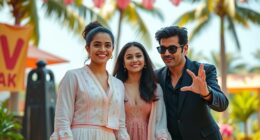Bollywood music has evolved from the melodic, emotional tunes of the 90s, influenced by composers like A.R. Rahman and Nadeem-Shravan, to a vibrant mix of genres today. Modern trends include remix culture, cross-genre experimentation, and global styles like hip-hop and electronic dance music, driven by digital platforms and social media. Viral remixes on TikTok or Spotify now shape popularity quickly. To discover how these changes continue shaping Bollywood’s soundscape, explore further.
Key Takeaways
- The 1990s introduced diverse melodies and technological advances, shifting from disco to more emotional and experimental music styles.
- Prominent composers like A.R. Rahman integrated Western elements, expanding Bollywood’s global musical influence.
- Digital platforms and social media revolutionized music distribution, enabling viral hits and remix culture to thrive.
- Remix culture blends nostalgic 90s sounds with contemporary genres, shaping modern Bollywood’s musical landscape.
- Industry trends now emphasize cross-genre experimentation, digital innovation, and audience engagement through viral, shareable content.
The Roots of Bollywood Music in the 1930s

The roots of Bollywood music in the 1930s are rooted in the advent of India’s first sound film, “Alam Ara,” which was released in 1931. This groundbreaking movie marked the beginning of synchronized sound in Indian cinema, making music an essential part of storytelling. Early Bollywood films drew heavily from classical Indian music, incorporating ragas and traditional melodies to evoke emotion and cultural pride. Song-and-dance routines became a hallmark, often resembling operatic performances with actors singing on-screen. During this period, around 930 films were produced, each featuring an average of ten songs, reflecting the central role of music in storytelling. These early innovations laid the foundation for Bollywood’s rich musical heritage, blending traditional sounds with cinematic storytelling.
The Ghazal Era and Its Influence on Early Bollywood Soundtracks
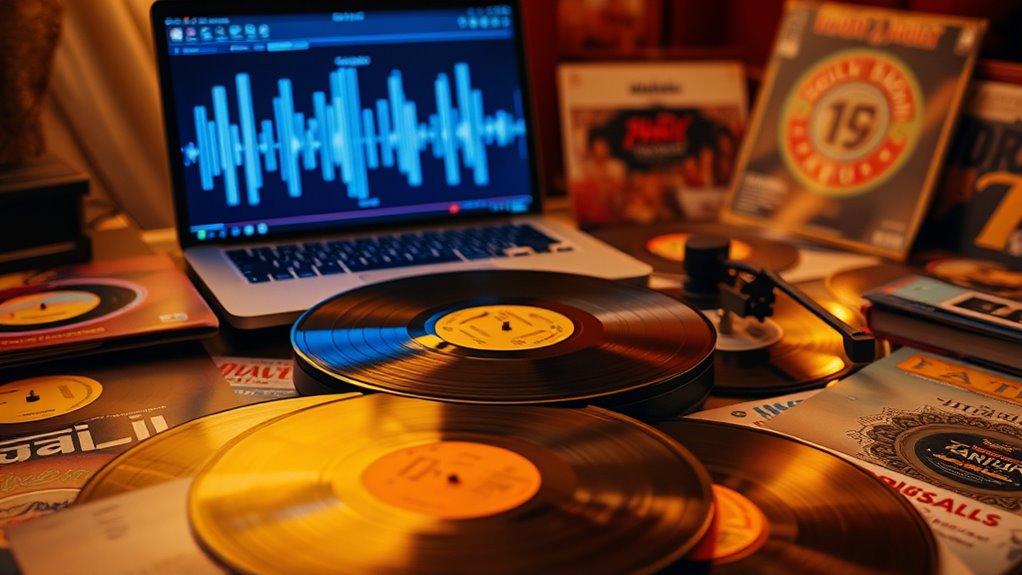
- Ghazals reflected cultural diversity, blending Persian and Indian styles.
- Film composers like Madan Mohan crafted memorable ghazals for Muslim social movies.
- Artists like Jagjit Singh revived the genre, ensuring its lasting impact on Bollywood’s musical heritage.
Golden Age Composers and the Rise of Classic Indian Melodies
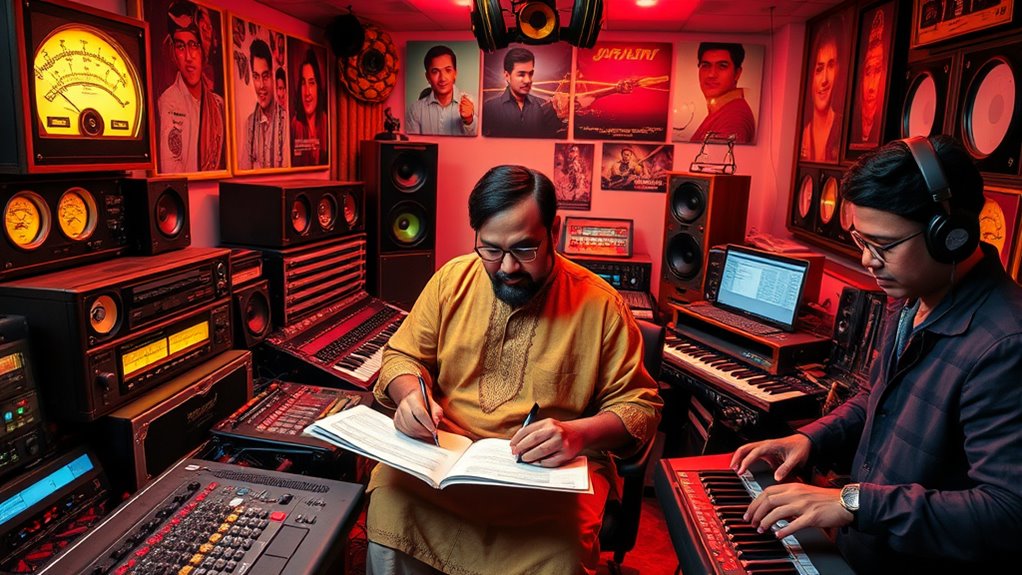
During the Golden Age of Bollywood, composers revolutionized Indian film music by blending classical ragas with cinematic storytelling, creating melodies that continue to resonate today. S.D. Burman, C. Ramchandra, and the Shankar-Jaikishen duo crafted timeless songs by combining traditional Indian instruments like sitar, flute, and tabla with emerging cinematic sounds. Naushad’s mastery of classical integration elevated film scores, while OP Nayyar’s distinctive style brought fresh energy to popular films. These composers collaborated with legendary singers such as Lata Mangeshkar and Kishore Kumar, delivering poetic lyrics by lyricists like Anand Bakshi. Their melodies emphasized emotional storytelling and cultural richness, establishing a foundation of melodious, meaningful music that influences Bollywood even now. Their innovative approach to melody and orchestration set a standard of musical excellence and timeless appeal. Additionally, the influence of Golden Age composers continues to inspire contemporary music directors, bridging traditional Indian music with modern genres, and the development of musical fusion has become a hallmark of modern Bollywood. Moreover, the use of authentic instruments helped preserve the traditional essence of Indian music within cinematic compositions.
Western Instruments and the Fusion of Global Sounds
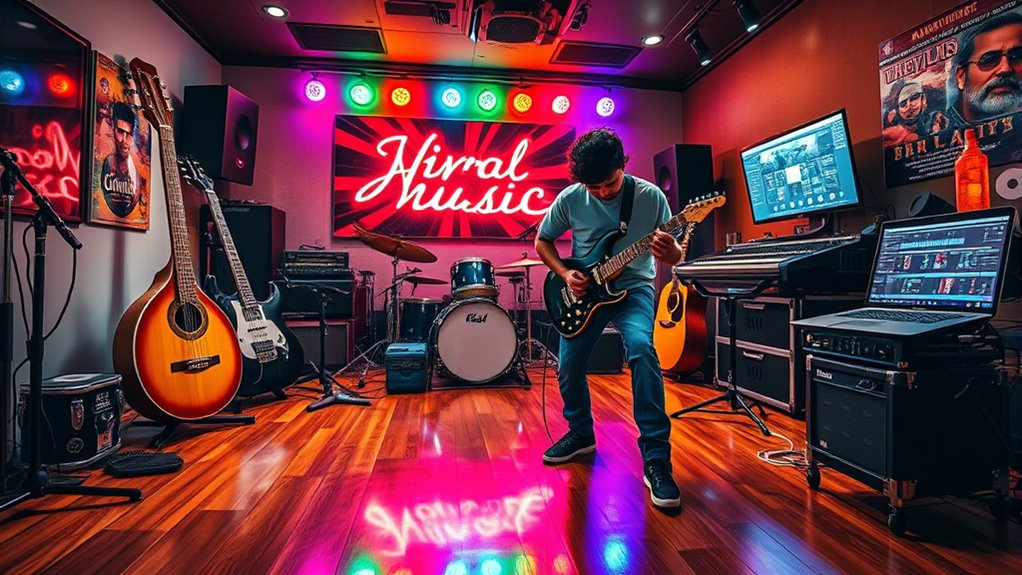
Western instruments began to influence Bollywood music, adding fresh textures and expanding the traditional soundscape. You notice how instruments like the electric guitar, saxophone, and drums started to blend seamlessly with Indian melodies, creating a richer, more diverse sound. This fusion led to a global mix of styles, appealing to wider audiences. Composers like A.R. Rahman integrated Western elements with Indian classical music, resulting in hit songs that broke cultural barriers. Cross-cultural collaborations increased, bringing together Indian and international artists. Digital platforms amplified this trend, offering worldwide exposure. Additionally, the integration of AI in media and entertainment has facilitated innovative music production techniques, further transforming Bollywood’s sound. Incorporating traditional instruments alongside Western ones has also played a significant role in shaping this evolving musical landscape, fostering a cross-cultural exchange that continues to evolve. For example, the use of fusion genres has become a hallmark of modern Bollywood music, blending diverse musical influences seamlessly.
The Transition: From Disco to New Musical Trends in the 1990s

The 1990s marked a significant shift in Bollywood music as it moved away from the disco-driven sound of the 1980s toward more diverse and emotionally nuanced melodies. You notice how the influence of disco gradually faded, making room for traditional and romantic themes that resonated more deeply with audiences. This change was fueled by new composers like A.R. Rahman and Nadeem-Shravan, who introduced fresh musical styles and experimented with genres. Advances in technology, such as multi-track recording, allowed for clearer orchestration and richer vocals. As a result, melodies became more complex, reflecting the emotional depth of films. The advent of digital recording techniques also contributed to the evolution of sound quality and production values during this era. Additionally, the integration of electronic instruments and digital sound processing created a more modern and polished sound that appealed to contemporary listeners. The increasing use of digital sound processing enabled composers to craft unique auditory textures, further enriching the musical landscape. Moreover, the adoption of computer-based music production facilitated more precise editing and innovative sound design. The rise of digital music distribution expanded the reach of Bollywood music, making it accessible to global audiences and influencing international music trends. This progression was supported by advanced production tools, which allowed for greater creative flexibility and innovation. This evolution set the stage for a vibrant, varied musical landscape that defined the 1990s and shaped future Bollywood trends.
The Resurgence of Ghazals and Romantic Ballads in the 90s
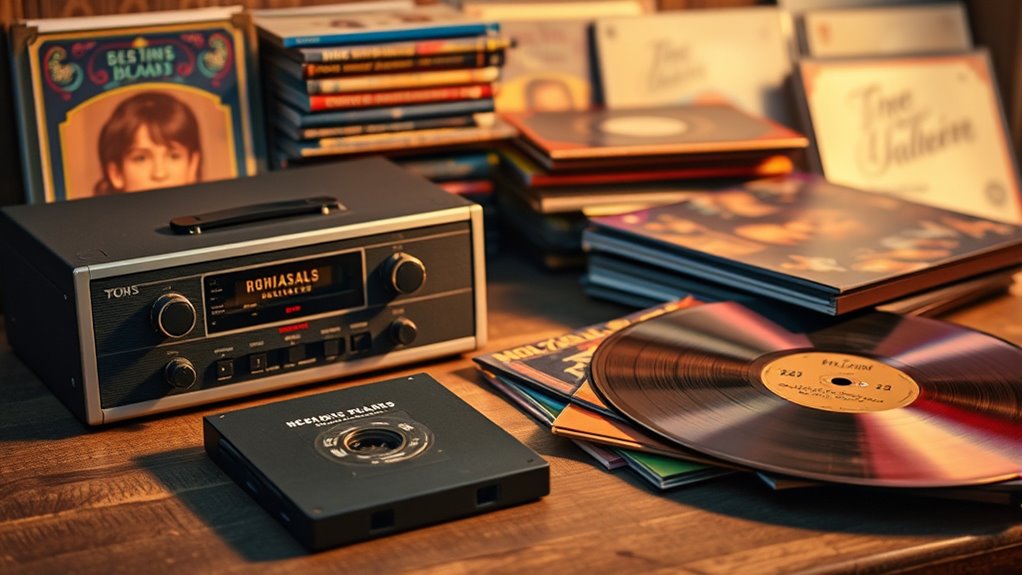
Here’s what defined this resurgence:
This resurgence was driven by romantic ghazal melodies, iconic film soundtracks, and their enduring influence on modern culture.
- Revival of ghazal-inspired romantic music, influenced by the emotional depth of *Aashiqui*.
- The dominance of popular romantic soundtracks from films like *Dilwale Dulhania Le Jayenge* and *Hum Dil De Chuke Sanam*.
- The lasting impact of these songs on modern playlists and cultural celebrations.
Technological Innovations Transforming Music Production
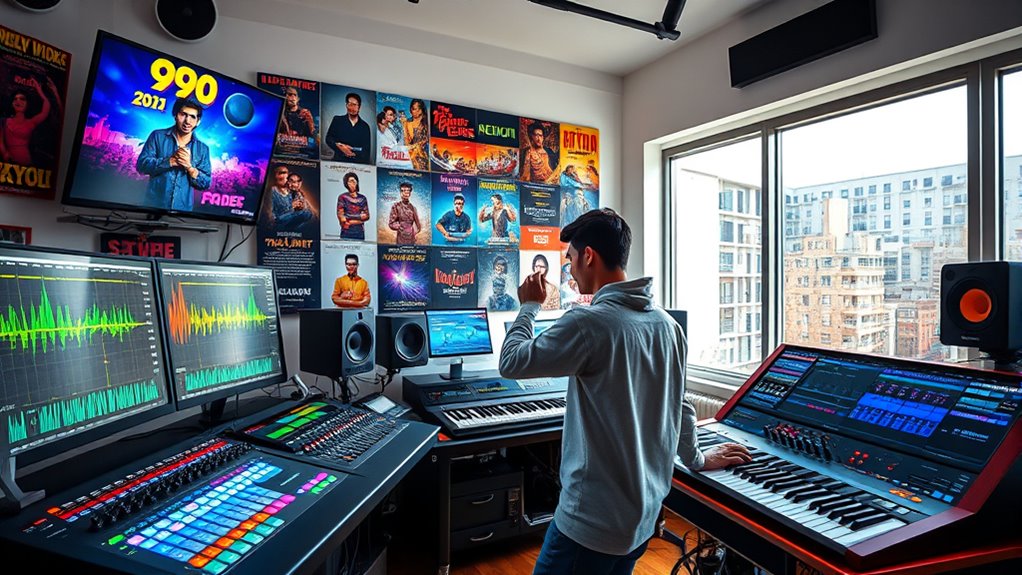
Technological innovations have revolutionized how Bollywood music is produced, making it more accessible and versatile than ever before. Digital Audio Workstations (DAWs) like FL Studio, Ableton Live, and Logic Pro X enable you to record, compose, and mix music from home studios, reducing reliance on large facilities. Streaming platforms such as Spotify and JioSaavn have transformed distribution, allowing independent artists to reach global audiences and enabling real-time trend analysis. AI and machine learning tools assist in remixing, mastering, and curating music, enhancing creativity and efficiency. Meanwhile, virtual and augmented reality technologies create immersive concert experiences and interactive videos, broadening audience engagement. These innovations empower you to experiment, collaborate remotely, and push creative boundaries, shaping the modern Bollywood soundscape. Additionally, support hours provided by various entertainment venues facilitate planning and enhance overall visitor experience.
Contemporary Trends: Remix Culture and Cross-Genre Blends
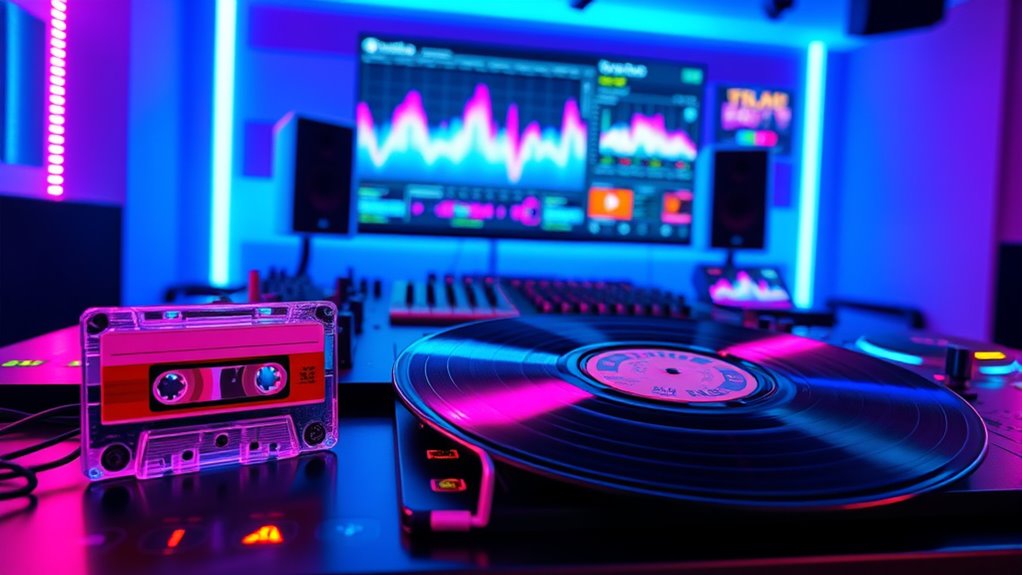
Contemporary Bollywood music is increasingly shaped by remix culture and cross-genre blends, reflecting both industry trends and audience preferences. You’ll notice many remixes rely on nostalgia, rehashing hits from the 90s to attract listeners, but this often hampers originality. Large labels focus on quantity, creating monopolies and sidelining independent artists, which limits creative innovation. Meanwhile, artists are blending global styles like hip-hop, techno, and electronic dance music into Bollywood tracks, appealing to younger, international audiences. This fusion results in fresh sonic textures and new hybrid genres, making soundtracks more dynamic. Embracing failure in creative practice encourages experimentation with these new sounds, fostering originality and resilience in the evolving industry. Additionally, understanding the Mental Wellbeing Index can support artists in maintaining emotional resilience amid industry pressures, promoting healthier creative environments. Incorporating industry trends such as digital platforms and social media also plays a crucial role in how these innovative sounds reach wider audiences and influence the industry’s direction. Furthermore, advancements in sound design techniques enable producers to craft more immersive and innovative audio experiences that resonate with modern listeners.
Viral Remixes and the Digital Age’s Role in Music Popularity
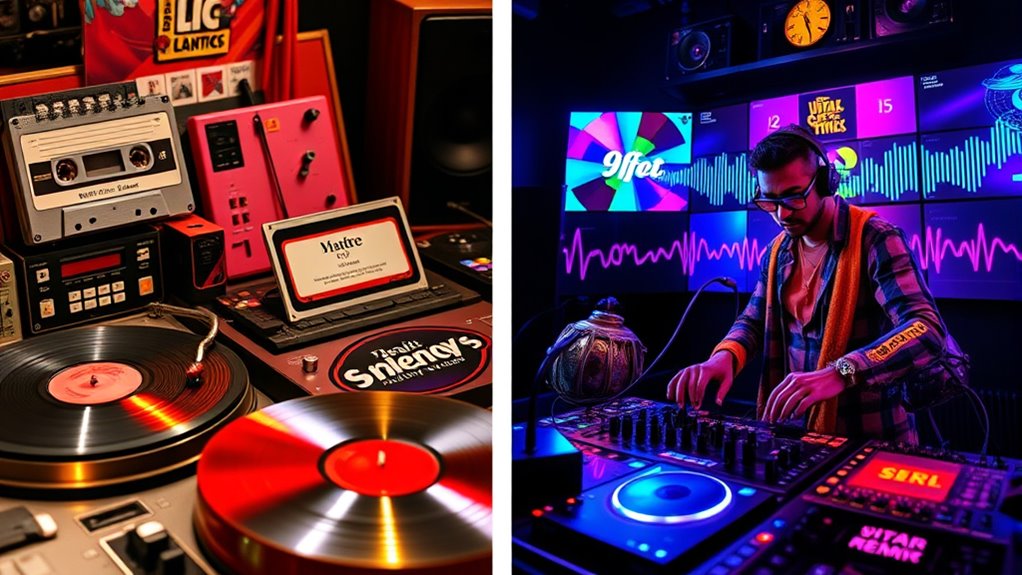
You see how social media and streaming platforms quickly amplify viral remixes, making them chart-toppers overnight. Platforms like TikTok and Spotify turn these remixes into global sensations by spreading them across different audiences. This digital landscape transforms how Bollywood music gains popularity and reaches fans worldwide. Additionally, predictive analytics are increasingly used to identify trending songs and tailor marketing efforts, further boosting a remix’s viral potential. The integration of sound healing science concepts also influences how certain remixes are crafted to evoke specific emotional responses, enhancing their appeal. Moreover, understanding the signs and symptoms of narcissistic influence can help creators recognize and avoid manipulative trends that may impact their artistic integrity. The use of cookies to personalize content and advertisements further helps in targeting audiences effectively, increasing a remix’s chances of going viral.
Social Media Amplification
Have you noticed how social media platforms like TikTok and Instagram Reels have transformed Bollywood music into viral sensations? These platforms amplify remixes through dance challenges, trending hashtags, and curated playlists, making songs reach millions within days. User-generated content plays a key role, with fans sharing dance covers and reactions that boost a song’s popularity. Social media algorithms prioritize trending challenges, further increasing exposure.
Here’s how social media fuels this trend:
- TikTok drives viral remixes with dance challenges and trends.
- Instagram Reels promotes remixes through curated playlists and influencer collaborations.
- User engagement, such as shares and comments, rapidly amplifies Bollywood music’s reach and popularity.
Streaming Platform Impact
Streaming platforms have become the backbone of Bollywood music’s modern rise, especially with viral remixes gaining momentum. They make it easy for tracks to go viral through shareability and algorithmic promotion, often reviving old melodies from the 90s and early 2000s. On platforms like YouTube and Spotify, remixed tracks frequently land in viral playlists, boosting streams and artist visibility across diverse audiences. Despite the massive consumption, revenue growth faces challenges because most users listen for free or via ads, limiting earnings. While paid subscriptions are slowly increasing—expected to reach over 20 million by 2027—they still represent a small portion of the user base. Overall, streaming has democratized access and expanded Bollywood music’s reach, but monetization remains a key hurdle.
Bollywood Music’s Impact on Global Culture and Industry Dynamics

Ever wonder how Bollywood music has become a powerful force shaping global culture and industry trends? Its reach is driven by the Indian diaspora in places like the U.S., U.K., and Canada, and amplified through digital platforms like Spotify and YouTube. In 2024, Indian artists’ tracks were discovered over 11.2 billion times, with stars like Arijit Singh gaining international followers and billions of views. Bollywood’s influence extends to Western music, inspiring pop, Broadway, and electronic remixes, while blending into international soundtracks. It also impacts fashion, dance, and celebrity culture globally.
Key points:
- Diaspora and digital platforms expand Bollywood’s global audience.
- Bollywood influences Western music, remixes, and international soundtracks.
- It drives industry growth through global markets, tours, and collaborations.
Frequently Asked Questions
How Did Bollywood Music Transition From Ghazals to Dance-Oriented Tracks?
You might wonder how Bollywood music shifted from soulful ghazals to energetic dance tracks. This change happened as composers embraced disco, electronic instruments, and modern production techniques in the 1980s and 1990s. Social trends favored more vibrant, upbeat music for films. Technology also played a role, allowing for innovative sounds. As a result, dance-oriented tracks gained popularity, reflecting a cultural shift towards energetic and contemporary music styles.
What Role Did Technological Advances Play in Shaping Modern Bollywood Sound?
You see, technological advances have revolutionized Bollywood sound by making music production more precise and creative. Digital tools like software and electronic instruments let you craft richer, layered tracks, while collaboration platforms connect you with artists worldwide. Streaming platforms give you instant access to a vast library, and social media helps you promote and remix songs easily. These innovations make modern Bollywood music more diverse, accessible, and globally connected.
How Do Remixes Influence the Cultural Perception of Classic Bollywood Songs?
You see remixes impact how people view classic Bollywood songs by blending tradition with modern beats, making old hits more relatable to younger audiences. While they help spread Bollywood globally and foster cross-cultural dialogue, many fans feel remixes risk losing the soul and emotional depth of the originals. You might notice debates online about whether remixes preserve or dilute the true essence of these timeless songs.
In What Ways Has Bollywood Music Expanded Its Global Reach and Influence?
You see Bollywood music expanding globally through increased streaming, collaborations, and social media trends. More Indian artists are featured on platforms like Spotify, gaining international listeners. Collaborations with global stars and remix culture boost its reach. Viral dance challenges and memes elevate Bollywood songs worldwide, while live concerts and festivals attract diverse audiences. You’re witnessing a vibrant, multicultural exchange that cements Bollywood’s influence across continents and genres.
How Do Contemporary Trends Reflect Societal Changes in India?
You see societal changes in India reflected through music trends—traditional melodies blending with modern beats, regional sounds gaining national prominence, and multilingual songs reaching global audiences. Streaming platforms amplify these shifts, making diverse genres accessible. Viral remixes and social media showcase youth identity and aspirations. As you witness this evolution, you realize how music becomes a mirror of India’s cultural diversity, technological growth, and social progress.
Conclusion
As Bollywood music evolves from timeless melodies to viral remixes, you witness a world where tradition dances with innovation. Imagine the classic tunes, rich and soulful, contrasting sharply with buzzing digital tracks that spread instantly across screens. This fusion creates a vibrant tapestry—where vintage charm meets modern energy—shaping a global culture. Embrace the journey, where every note, old or new, sparks a story, connecting hearts across generations and borders.






